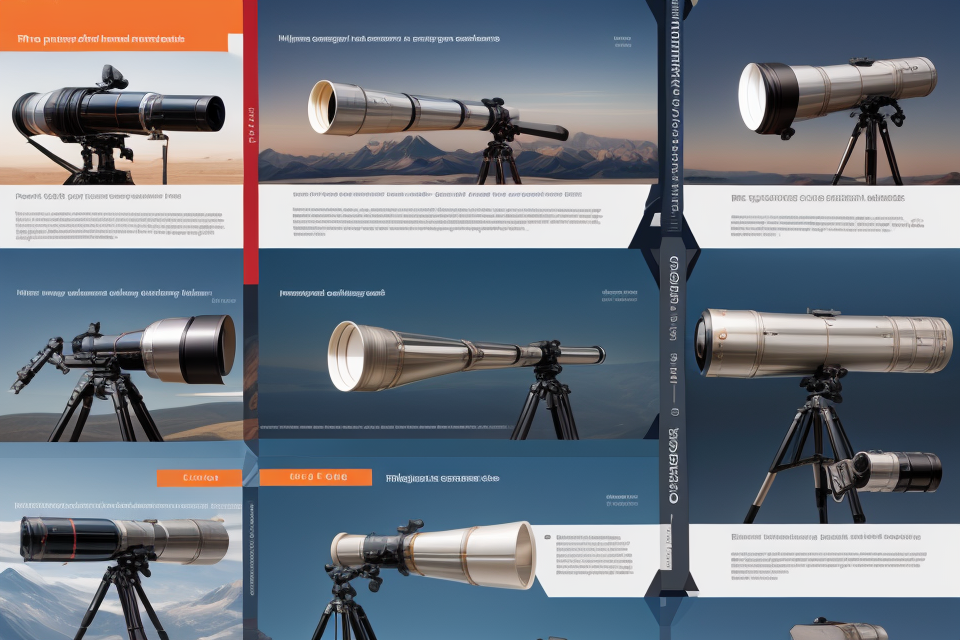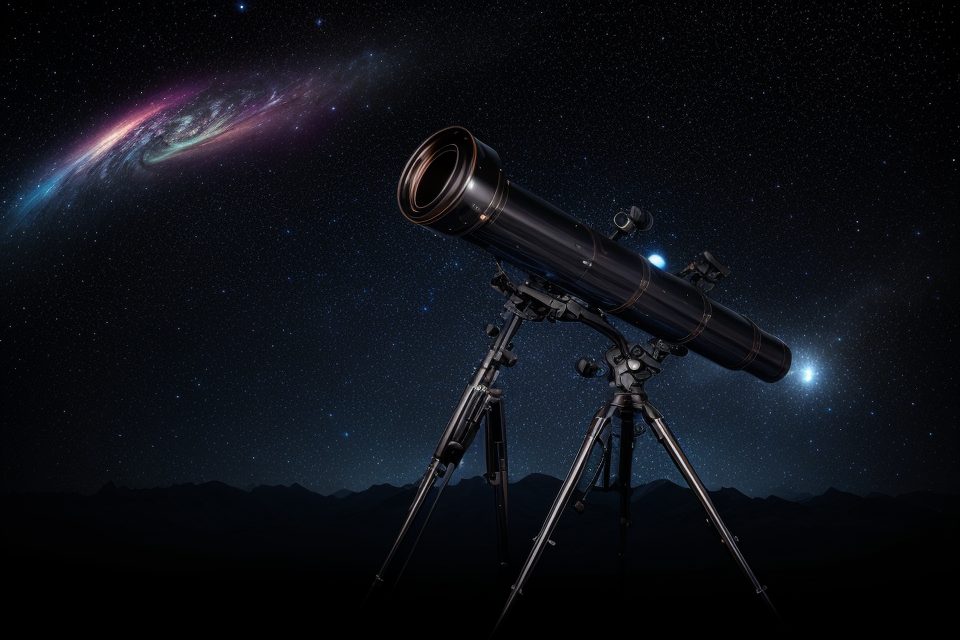The debate between reflector and refractor telescopes has been ongoing for years, with both having their own unique advantages and disadvantages. When it comes to observing planets, which telescope reigns supreme? In this article, we will explore the pros and cons of both reflector and refractor telescopes, and ultimately determine which one is best suited for planetary observation. So, grab your telescope and let’s dive in!
When it comes to planetary observation, both reflector and refractor telescopes have their own advantages and disadvantages. Reflector telescopes are typically larger and can gather more light, making them ideal for viewing faint objects like planets and galaxies. They also tend to be less expensive than refractor telescopes. On the other hand, refractor telescopes are known for their sharp and clear images, making them ideal for detailed observations of planets and their moons. They also tend to be more portable and easier to set up than reflector telescopes. Ultimately, the choice between a reflector or refractor telescope for planetary observation will depend on your specific needs and preferences.
Understanding Reflector and Refractor Telescopes
Reflector Telescopes
Definition and Key Features
A reflector telescope is an optical instrument that uses a mirror to gather and reflect light, rather than a lens. It is composed of a primary mirror, which is the main mirror, and a secondary mirror, which is placed in the path of the light to direct it towards the eyepiece. Reflector telescopes are known for their compact size, lightweight design, and high magnification capabilities.
Advantages and Disadvantages
One of the main advantages of reflector telescopes is their compact size, which makes them easier to transport and set up than refractor telescopes. They also tend to be less expensive than refractor telescopes, and can provide high magnification without sacrificing image quality. Additionally, reflector telescopes are less prone to chromatic aberration, a type of distortion that can occur in refractor telescopes due to the use of glass lenses.
However, reflector telescopes can be more difficult to align and collimate than refractor telescopes, and may require more maintenance. They are also more sensitive to temperature changes and vibrations, which can affect the image quality.
Examples of Reflector Telescopes
Some examples of reflector telescopes include the Newtonian reflector, the Schmidt-Cassegrain reflector, and the Maksutov-Cassegrain reflector. The Newtonian reflector is a simple design that uses a parabolic mirror to gather and reflect light. The Schmidt-Cassegrain reflector is a more complex design that uses a hyperbolic primary mirror and a convex secondary mirror to provide high magnification and a wide field of view. The Maksutov-Cassegrain reflector is similar to the Schmidt-Cassegrain reflector, but uses a corrector lens to improve the image quality.
Refractor Telescopes
A refractor telescope is a type of optical telescope that uses a lens to gather and focus light. The main components of a refractor telescope include an objective lens, an eyepiece lens, and a tube that houses the lenses. The objective lens is located at the front of the telescope and is responsible for collecting light from the observed object. The eyepiece lens, located at the rear of the telescope, magnifies the image and allows the observer to see the object in greater detail.
One of the main advantages of a refractor telescope is its ability to produce sharp, high-contrast images with minimal distortion. This is due to the fact that the light path is not obstructed by any mirrors, which can cause unwanted reflections and diffractions. Refractor telescopes are also relatively compact and lightweight, making them easy to transport and set up.
However, refractor telescopes have some disadvantages. One of the main drawbacks is their limited aperture, which can make them less effective at detecting faint objects. Additionally, refractor telescopes can be more expensive than other types of telescopes due to the cost of manufacturing high-quality lenses.
Examples of Refractor Telescopes
There are several examples of refractor telescopes that have been used for planetary observation. One notable example is the refractor telescope used by Galileo Galilei in the 17th century. Galileo’s telescope had a focal length of approximately 30 feet and was used to observe the moons of Jupiter and the mountains and craters on the moon. Another example is the Great Refractor telescope at the University of California, Berkeley, which has a focal length of 36 feet and was used to study the surface of Mars in the late 19th century.
Factors to Consider in Choosing a Telescope for Planetary Observation
Aperture
When it comes to choosing a telescope for planetary observation, one of the most important factors to consider is the aperture. Aperture refers to the diameter of the telescope’s objective lens or mirror, and it is a key determinant of the telescope’s light-gathering ability. The larger the aperture, the more light the telescope can collect, and the higher the resolution and contrast of the images it produces.
Comparing Reflector and Refractor Apertures
Both reflector and refractor telescopes have different aperture sizes, and each type has its own advantages and disadvantages. Reflector telescopes use mirrors to gather and focus light, while refractor telescopes use lenses.
In general, reflector telescopes tend to have larger apertures than refractor telescopes, which makes them more suitable for planetary observation. This is because the larger aperture allows for more light to be gathered, resulting in brighter and clearer images.
However, refractor telescopes have the advantage of being more compact and portable, making them easier to transport and set up. They also tend to have better image stability and reduced optical distortion compared to reflector telescopes.
How to Determine the Optimal Aperture for Planetary Observation
The optimal aperture for planetary observation depends on several factors, including the size of the planetary object, the distance between the telescope and the object, and the desired level of detail in the images.
For example, when observing planets such as Jupiter and Saturn, a larger aperture is needed to capture the details of the planet’s cloud bands and atmospheric features. In these cases, a reflector telescope with an aperture of 8 inches or larger is recommended.
On the other hand, for observing smaller planetary objects such as moons or asteroids, a smaller aperture may be sufficient. In these cases, a refractor telescope with an aperture of 4-6 inches may be a good choice.
It is important to note that aperture is just one factor to consider when choosing a telescope for planetary observation. Other factors such as magnification, resolution, and image stabilization also play a crucial role in determining the quality of the images produced.
Magnification
When it comes to planetary observation, magnification is a crucial factor to consider when choosing a telescope. Magnification refers to the ability of a telescope to make objects appear larger and closer. The power of magnification is usually expressed as a ratio, such as 10x or 20x. A higher magnification ratio means that the object will appear larger and closer.
Both reflector and refractor telescopes have different magnification capabilities. Reflector telescopes typically have a higher magnification power compared to refractor telescopes. This is because the design of a reflector telescope allows for a longer focal length, which results in a higher magnification power. On the other hand, refractor telescopes have a shorter focal length, which limits their magnification power.
When determining the optimal magnification for planetary observation, it is important to consider the size of the telescope, the quality of the optics, and the observer’s experience level. A larger telescope with better optics will typically provide a clearer and more detailed image at higher magnifications. However, a smaller telescope with lower magnification may still provide a satisfactory view of the planets.
It is also important to consider the observer’s experience level when determining the optimal magnification. A beginner observer may find it difficult to observe the planets at high magnifications, while an experienced observer may be able to view the planets in greater detail at higher magnifications.
In summary, when choosing a telescope for planetary observation, it is important to consider the magnification capabilities of both reflector and refractor telescopes. A higher magnification power may provide a clearer and more detailed image of the planets, but it is also important to consider the size of the telescope, the quality of the optics, and the observer’s experience level to determine the optimal magnification for planetary observation.
Optical Quality
When it comes to choosing a telescope for planetary observation, optical quality is one of the most important factors to consider. Optical quality refers to the clarity and sharpness of the images that a telescope produces. A telescope with good optical quality will allow you to see more detail in the planets and their moons, as well as in other celestial objects.
Comparing Reflector and Refractor Optical Quality
Both reflector and refractor telescopes can provide excellent optical quality, but they do so in different ways. Reflector telescopes use mirrors to gather and focus light, while refractor telescopes use lenses.
Reflector telescopes are often preferred for planetary observation because they tend to be less expensive and more portable than refractor telescopes. They also tend to have a wider field of view, which can be useful for scanning the sky and finding objects.
Refractor telescopes, on the other hand, are known for their excellent optical quality. They are often preferred for detailed observation of planets and moons, as well as for astrophotography. However, they can be more expensive and less portable than reflector telescopes.
How to Determine the Optimal Optical Quality for Planetary Observation
When choosing a telescope for planetary observation, it’s important to consider your own needs and preferences. If you’re a beginner, a reflector telescope may be a good choice because it’s generally more affordable and easier to use. If you’re an experienced observer, a refractor telescope may be a better choice because of its superior optical quality.
It’s also important to consider the size of the telescope. A larger telescope will generally provide better optical quality, but it may also be more expensive and more difficult to transport. If you plan to observe from a fixed location, such as a backyard or a remote observatory, a larger telescope may be a good choice. If you plan to take your telescope on the go, a smaller, more portable model may be a better option.
Ultimately, the best telescope for planetary observation is the one that meets your needs and fits your budget. By considering factors such as optical quality, portability, and cost, you can choose a telescope that will allow you to explore the wonders of our solar system in greater detail.
Portability and Durability
Importance of Portability and Durability
When choosing a telescope for planetary observation, portability and durability are two crucial factors to consider. These qualities can greatly impact the overall experience and effectiveness of your observations. A telescope that is not portable may limit your ability to observe from different locations, while a telescope that is not durable may not withstand the elements and perform optimally over time.
Comparison of Reflector and Refractor Portability and Durability
Both reflector and refractor telescopes have their own strengths and weaknesses when it comes to portability and durability. Reflector telescopes are generally more portable due to their smaller size and lightweight design, making them easier to transport and set up in different locations. However, they may not be as durable as refractor telescopes, which are typically made with higher-quality materials and construction. Refractor telescopes may be more resistant to damage from rough handling or exposure to the elements, but they may also be more difficult to transport and set up in remote locations.
Determining Optimal Portability and Durability for Planetary Observation
When choosing a telescope for planetary observation, it is important to consider your specific needs and preferences. If you plan to observe from a variety of locations, a more portable telescope may be a better choice. However, if you plan to observe from a fixed location or transport your telescope less frequently, a more durable telescope may be more suitable. It is also important to consider the specific conditions in which you will be using your telescope, such as exposure to wind, rain, or extreme temperatures. Choosing a telescope with the right balance of portability and durability can ensure that you have a reliable and enjoyable observing experience.
Price
When it comes to choosing a telescope for planetary observation, price is an important factor to consider. The cost of a telescope can vary greatly depending on the type, size, and quality of the instrument. In general, reflector telescopes tend to be less expensive than refractor telescopes.
Comparison of Reflector and Refractor Prices
Reflector telescopes are often less expensive than refractor telescopes due to their simpler design. This is because reflector telescopes use mirrors to gather and focus light, whereas refractor telescopes use lenses. Reflector telescopes are also typically easier to manufacture, which contributes to their lower cost.
That being said, there are many factors that can affect the price of a telescope, including the size of the instrument, the quality of the optics, and the brand. Some high-end reflector telescopes can be just as expensive as refractor telescopes, and some lower-end refractor telescopes can be more affordable than entry-level reflector telescopes.
How to Determine the Optimal Budget for Planetary Observation
When it comes to determining the optimal budget for planetary observation, it’s important to consider your goals and priorities. If you’re a beginner and just starting out in astronomy, a lower-priced telescope may be a good option to get started with. However, if you’re an experienced astronomer looking for high-quality optics and advanced features, you may need to invest a bit more money.
Ultimately, the optimal budget for planetary observation will depend on your individual needs and preferences. It’s important to do your research and compare different options before making a purchase. With careful consideration and planning, you can find a telescope that meets your needs and budget.
FAQs
1. What is the difference between a reflector and a refractor telescope?
A reflector telescope uses a mirror to gather and focus light, while a refractor telescope uses a lens. Reflector telescopes are generally larger and more powerful than refractor telescopes, but refractor telescopes have a wider field of view.
2. Which type of telescope is better for observing planets?
Both reflector and refractor telescopes can be used for observing planets, but the choice depends on the observer’s preferences and needs. Reflector telescopes tend to be better for viewing faint objects due to their larger aperture and greater light-gathering power, while refractor telescopes offer a wider field of view and can be used for viewing a larger area of the sky at once.
3. Are reflector telescopes better for viewing detailed surface features on planets?
No, refractor telescopes are generally better for viewing detailed surface features on planets. Refractor telescopes have a longer focal length, which means they can magnify objects more than reflector telescopes. This makes them ideal for viewing small, detailed features on planets.
4. Are refractor telescopes more expensive than reflector telescopes?
Yes, refractor telescopes are generally more expensive than reflector telescopes. This is because the glass used in the lens of a refractor telescope is more expensive than the mirror used in a reflector telescope. However, the price difference can vary depending on the specific model and brand of the telescope.
5. Can I use a reflector telescope for planetary observation?
Yes, you can use a reflector telescope for planetary observation. In fact, many professional observatories use reflector telescopes for this purpose. However, if you are just starting out, a refractor telescope may be a better choice as it is easier to use and offers a wider field of view.



